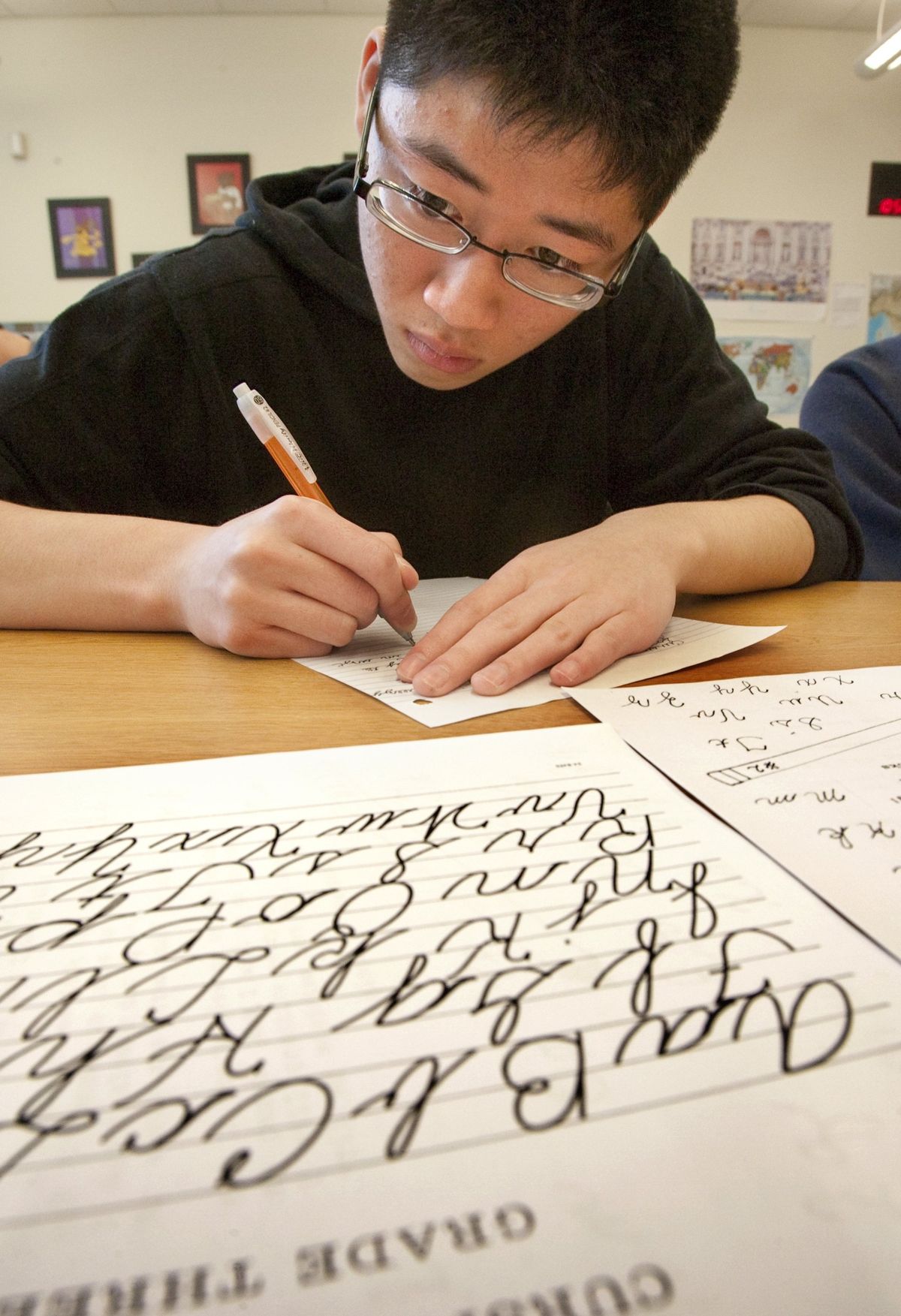Students relearn the write stuff
Seattle schools offer remedial cursive classes

SEATTLE – Just like in third grade, a dozen high-school juniors and seniors slant their papers to the right, with one corner pointed toward their stomachs. They pick up their pens or pencils and follow along as a guest instructor leads them through the loops and slants and curves of cursive writing.
Sure, they learned cursive when they were in elementary school, but they use it so rarely that they’ve forgotten a lot of it.
Even for these students – “high achievers” taking advanced-placement Latin at Seattle’s Roosevelt High School – cursive is quaint.
“I never write in cursive,” said Annika Kounts, who struggled when she had to write a few cursive sentences as part of the SAT college-entrance exam.
“I gave up and printed,” classmate Kevin Tang said. “I started writing it in cursive, but it took me too long.”‘
Cursive is encouraged but no longer required in Seattle Public Schools, and Washington state’s education department doesn’t insist it be taught, either. That doesn’t mean early elementary-school teachers don’t teach it – the vast majority still do in Seattle and elsewhere. But as students use computers more and academic demands increase, many schools no longer devote as much time to cursive as they once did.
Roosevelt Latin teacher Nora MacDonald says it was about 10 years ago when she first noticed that fewer of her students used cursive for homework assignments. For the past five years, she said, almost all of them used block printing.
MacDonald last year became so annoyed with the state of her students’ handwriting that she asked her seniors if they wanted a short refresher in cursive. In some cases, their printing was so messy that she feared their grades on the advanced-placement Latin exam would suffer because graders wouldn’t be able to decipher their answers.
The students thought a day of cursive would be fun, so for the past two years, MacDonald has invited friend and retired third-grade teacher JoAnne Jugum to give a one-hour review.
“The value of cursive writing is getting students to realize there is a time for taking time to complete something,” MacDonald said. “They’re so impatient because of how fast the computer goes. The computer is a wonderful tool, but there is also a personal satisfaction that comes with being able to create something with your own hands.”
Handwriting, she tells students as she introduces Jugum, “is an extension of yourself.”
Jugum passes out the cursive alphabet – that classic chart of perfectly formed A’s and B’s, and tough W’s and Q’s. She reviews the basic cursive shapes – the under curve, the over curve, the straight slant, the retrace.
Students bend their heads over their papers, concentrating. Jugum’s examples refresh their memories, but it’s still slow going for some. After one page of letters, some shake out their hands because their muscles are tired.
They marvel at the cursive in a letter written by MacDonald’s father and in copies of historical documents that Jugum brought to show them.
“That’s crazy,” said Kounts, looking at line after line of the perfectly slanted script in the Constitution.
There are those who wonder whether it’s time to bury cursive altogether. Yet it’s still holding on, perhaps just by the force of tradition and one simple economic fact: Schools can’t afford to put computers on every student’s desk.
Experts are mixed on whether cursive should be preserved. There are still reasons to learn it – to have a good signature, to read historical documents in the original, to write formal thank-you notes.
Some research, including a study led by University of Washington professor Virginia Berninger, shows that handwriting (printing or cursive) has some advantages over typing. Elementary students write faster, write more, and include more ideas when they’re writing by hand, Berninger said.
Yet others say it doesn’t matter how students write. What’s important, they note, is that they can write or type fluently enough so that the method doesn’t get in the way of putting their ideas on paper.